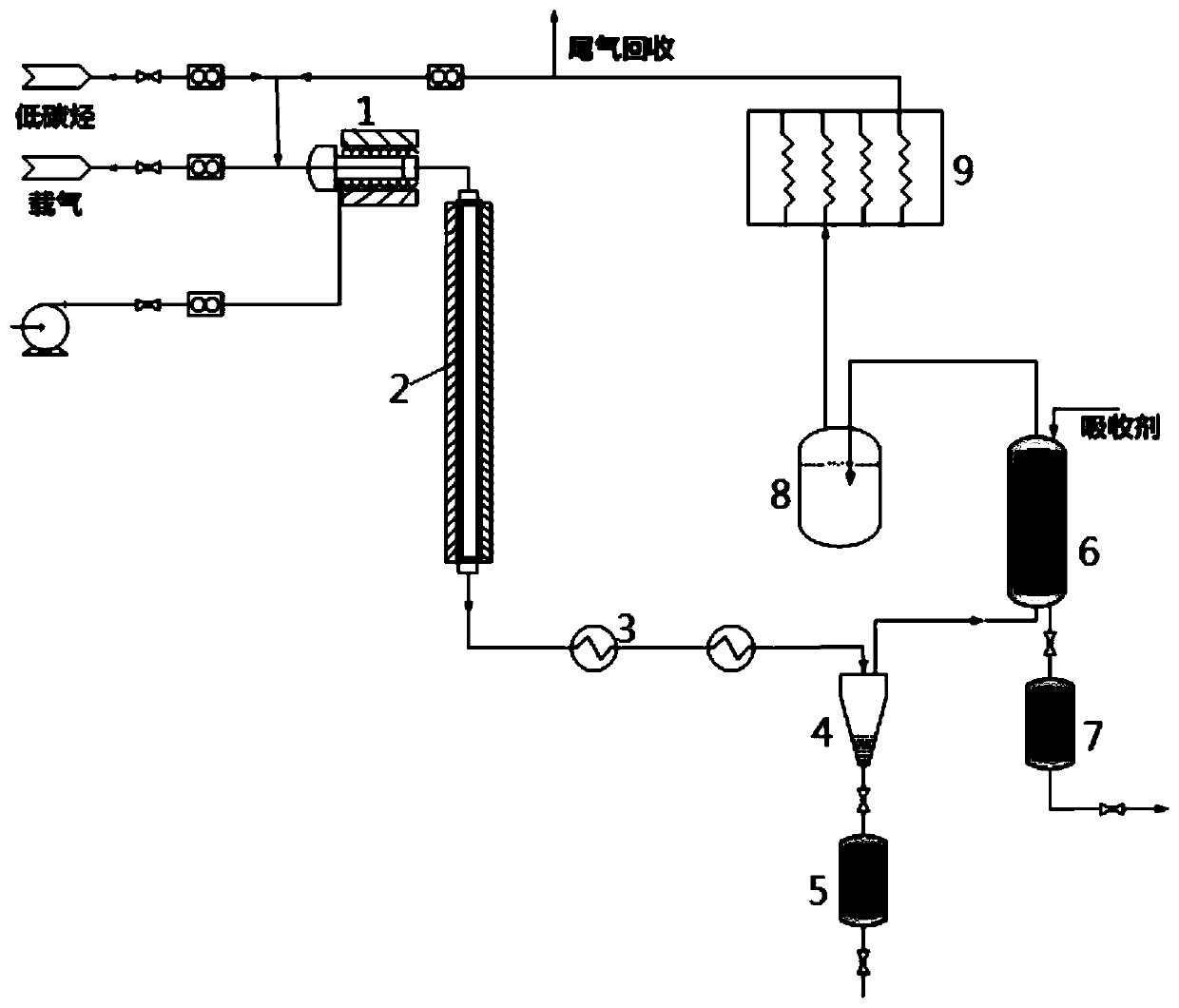Method for preparing ketene compound
A technology for compounds and ketenes, which is applied in the field of preparing ketene compounds, can solve the problems of low relative conversion rate and yield index, low single-pass yield of ketene compounds, limited popularization and application, etc., and achieves low production cost, The effect of less carbon deposition and less pyrolysis by-products
- Summary
- Abstract
- Description
- Claims
- Application Information
AI Technical Summary
Problems solved by technology
Method used
Image
Examples
Embodiment 1
[0059] like figure 1 As shown, acetic acid (purity 99%), nitrogen, light hydrocarbons (methane: ethylene mass ratio=6:4) enter preheater 1 after mixing with the mass ratio of 70% / 20% / 10%, the mass of the mixture The flow rate is 5.71g / min. After being heated and vaporized by the preheater 1, the temperature rises to 350°C, and then passes into the high-temperature cracking reactor 2, where the reaction temperature is 750°C and the reaction pressure is 25kPa. After the reaction, the mixed gas passes through the secondary condenser 3 to liquefy the heavy components, and after condensation, the gas-liquid mixture enters the gas-liquid separator 4 to separate the liquid phase and transfer it to the condensate storage tank 5, while the gas phase rich in ketene (DK) Points enter the absorption tower 6 from the bottom. The operating temperature of the absorption tower is 110°C, the pressure is 2atm, the absorbent is isobutyl isobutyrate, and the flow rate is 5mL / min. After two-phas...
Embodiment 2
[0063] like figure 1 As shown, isobutyric acid (purity 99%), nitrogen, light hydrocarbons (ethane: propylene mass ratio = 6:4) are mixed with 70% / 17.44% / 12.56% of the mass ratio and then enter the preheater 1, The mass flow rate of the mixture is 5.43g / min. After being heated and vaporized by the preheater 1, the temperature rises to 330°C, and then passes into the high temperature cracking reactor 2, wherein the reaction temperature is 550°C and the reaction pressure is 40kPa. After the reaction, the mixed gas passes through the secondary condenser 3 to liquefy the heavy components. After condensation, the gas-liquid mixture enters the gas-liquid separator 4 to separate the liquid phase and transfer it to the condensate storage tank 5, which is rich in dimethyl ketene (DMK) The gas phase components enter the absorption tower 6 from the bottom. The operating temperature of the absorption tower is 120°C, the pressure is 3atm, the absorbent is dimethyl 1,4-cyclohexyldicarboxyla...
Embodiment 3
[0067] like figure 1As shown, isobutyric anhydride (purity 98%), nitrogen, low-carbon hydrocarbons (ethane: propylene: propane mass ratio = 4:3:3) are mixed at a mass ratio of 83.3% / 11.7% / 5% and then enter the pre- Heater 1, the mass flow rate of the mixture is 6.0g / min, the temperature rises to 330°C after being heated and vaporized by preheater 1, and then passes into high-temperature cracking reactor 2, where the reaction temperature is 450°C and the reaction pressure is 72kPa . After the reaction, the mixed gas passes through the secondary condenser 3 to liquefy the heavy components. After condensation, the gas-liquid mixture enters the gas-liquid separator 4 to separate the liquid phase and transfer it to the condensate storage tank 5, which is rich in dimethyl ketene (DMK) The gas phase components enter the absorption tower 6 from the bottom. The operating temperature of the absorption tower is 117°C, the pressure is 3atm, the absorbent is dimethyl 1,4-cyclohexyldicarb...
PUM
 Login to View More
Login to View More Abstract
Description
Claims
Application Information
 Login to View More
Login to View More - R&D Engineer
- R&D Manager
- IP Professional
- Industry Leading Data Capabilities
- Powerful AI technology
- Patent DNA Extraction
Browse by: Latest US Patents, China's latest patents, Technical Efficacy Thesaurus, Application Domain, Technology Topic, Popular Technical Reports.
© 2024 PatSnap. All rights reserved.Legal|Privacy policy|Modern Slavery Act Transparency Statement|Sitemap|About US| Contact US: help@patsnap.com








